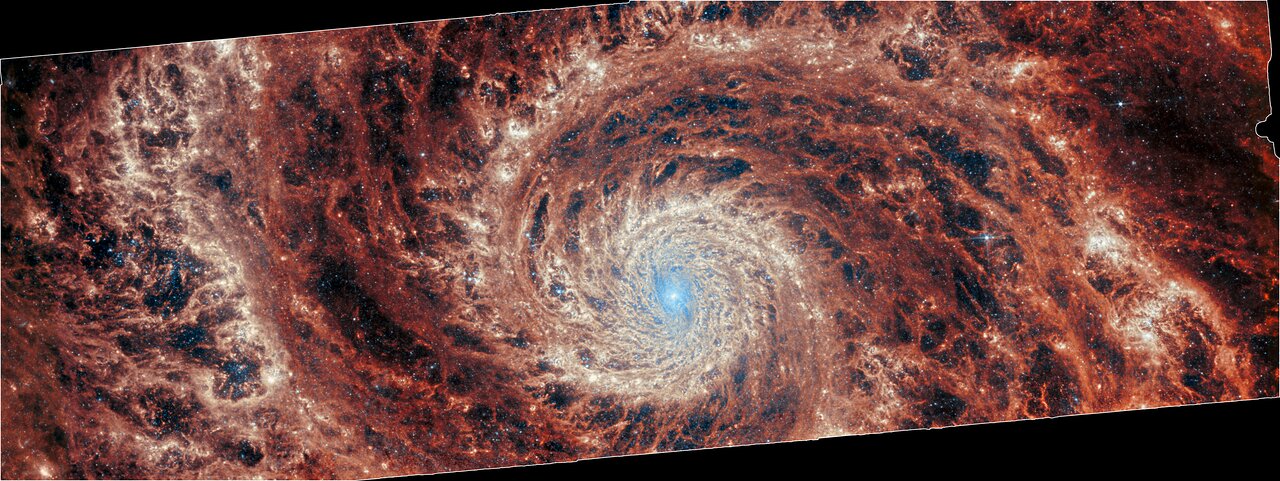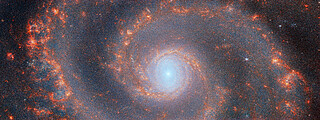Webb’s infrared views of M51
The graceful winding arms of the grand-design spiral galaxy M51 stretch across these images from the NASA/ESA/CSA James Webb Space Telescope. Unlike the menagerie of weird and wonderful spiral galaxies with ragged or disrupted spiral arms, grand-design spiral galaxies boast prominent, well-developed spiral arms like the ones showcased in this image. The image on the left was captured by Webb’s Near-InfraRed Camera (NIRCam), while the image on the right was taken by the Mid-InfraRed Instrument (MIRI).
By viewing these images side-by-side, the dramatic change in the appearance of the galaxy medium is apparent. While light from newly formed stars is responsible for most of the ionised gas emission surrounding stellar cradles (this is visible as red emission in the NIRCam image on the left), the light reprocessed by dust grains and molecules illuminate the cold gas of the galaxy showing a dramatic filamentary structure in the MIRI image to the right.
M51 — also known as NGC 5194 — lies about 27 million light-years away from Earth in the constellation Canes Venatici, and is trapped in a tumultuous relationship with its near neighbour, the dwarf galaxy NGC 5195. The interaction between these two galaxies has made these galactic neighbours one of the better-studied galaxy pairs in the night sky. The gravitational influence of M51’s smaller companion is thought to be partially responsible for the stately nature of the galaxy’s prominent and distinct spiral arms. If you would like to learn more about this squabbling pair of galactic neighbours, you can explore earlier observations of M51 by the NASA/ESA Hubble Space Telescope here.
These Webb observations of M51 are part of a series of observations collectively titled Feedback in Emerging extrAgalactic Star clusTers, or FEAST. The FEAST observations were designed to shed light on the interplay between stellar feedback and star formation in environments outside of our own galaxy, the Milky Way. Stellar feedback is the term used to describe the outpouring of energy from stars into the environments which form them, and is a crucial process in determining the rates at which stars form. Understanding stellar feedback is vital to building accurate universal models of star formation.
The aim of the FEAST observations is to discover and study stellar nurseries in galaxies beyond our own Milky Way. Before Webb became operative, other observatories such as the Atacama Large Millimetre Array in the Chilean desert and Hubble have given us a glimpse of star formation either at the onset (tracing the dense gas and dust clouds where stars will form) or after the stars have destroyed with their energy their natal gas and dust clouds. Webb is opening a new window into the early stages of star formation and stellar light, as well as the energy reprocessing of gas and dust. Scientists are seeing star clusters emerging from their natal cloud in galaxies beyond our local group for the first time. They will also be able to measure how long it takes for these stars to pollute with newly formed metals and to clean out the gas (these time scales are different from galaxy to galaxy). By studying these processes, we will better understand how the star formation cycle and metal enrichment are regulated within galaxies as well as what are the time scales for planets and brown dwarfs to form. Once dust and gas is removed from the newly formed stars, there is no material left to form planets.
Note: The black region visible around the MIRI image (right) is due to the rotation and cropping of the image to align with the NIRCam image for the slider tool. The full MIRI image can be viewed here.
Credit:ESA/Webb, NASA & CSA, A. Adamo (Stockholm University) and the FEAST JWST team
About the Images
| Id: | potm2308 | |
|---|---|---|
| Release date: | 29 August 2023, 10:00 | |





